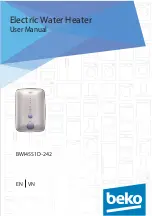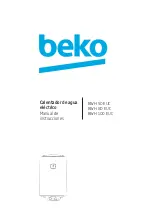
10
Instruction leaflet and warnings for water softeners
english
Automatic Water Softeners MINI and MAXI
TECHNICAL DATA
• Operating pressure: Min. 2 ÷ Max. 8,6 bar (0,86 MPa)
Picture 3 LEGEND:
A
Water Inlet
B
Water Outlet
1
Inlet tap
2
BY-PASS tap
3
Outlet tap
4
Nonreturn valve (DVGW DIN 1988 T2)
5
Glass
6
Drain
7
Height of the overflow hole
•
Working Position:
taps
1-3
open,
tap
2
closed
•
By-Pass Position:
taps
1-3
closed,
tap
2
open
This leaflet is an integral part of the product. Please
read the warnings provided carefully as these provi-
de important information concerning the safe instal-
lation, use and servicing of this product. This water
softener is intended to be used to soften cold
drinking water only, any other use is considered
improper and as such unreasonable.
•
ATTENTION:
for regeneration use only sodium
chloride NaCl (kitchen-salt). Acid or basic sub-
stances, as well as solvents and different chemi-
cal products, are not to be used.
Be sure of the constant presence of salt in the
pickle. In case it should lack and considering that
it is a fundamental element for resins regenera-
tion, the water softener will carry normally out
the operations it has been programmed to execu-
te but the water coming out from the fixture will
not be softened.
Therefore, you should check the presence of salt
in the pickle at regular intervals and add it in ca-
se it is lacking (fig. 2).
1. INSTALLATION WARNINGS
• Electric installation, waterworks and unloading
system must be already installed by the client in
the right position in order to allow a correct in-
stallation of the water softener.
• The Installer cannot change the existing system
provided by the client.
• Place the water softener on a horizontal surface
in a place easy to be reached in order to carry
out setting and salt loading operations.
• Do not install the water softener in an area whe-
re the temperature is higher than 49°C or lower
than 4°C and near acid and/or corrosive pro-
ducts.
2. WATER NETWORK CONNECTION
(fig. 3)
The water softener has to be set up in compliance
with the laws in force and according to the manu-
factuer’s instructions. The installation has to be car-
ried out by qualified personnel.
First of all, it is necessary to set up a tap between
the water network and the loading pipe. It will be
used to stop the water flow, in case of need.
A connection as the one described in fig. 3 with 3
ball valves and one nonreturn valve is recommen-
ded (DVGW, DIN 1988 T2), in order to protect the
water softener from possible hot water backflow, in
case the fixture supplies water to one or more boi-
lers.
The water coming out from the unloading system of
the water while regenerating must be conveyed th-
rough a pipe in a pit, placed lower than the water
softener, if possible (6).
If this is not possible, that is, if the pit has been
placed higher than the water softener, you need to
be careful since 1.8 m is the maximum height ac-
ceptable provided that the distance from the water
softener unloading system is not longer than 5 m
and the pressure of the feeding water network is at
least 2.8 bar.
For different installations, please contact your sup-
plier.
• The pipe connecting the water softener unloa-
ding system to the pit must not be flattened or
have too narrow elbows. The flowing water must
not come up against any obstacle. If not, the wa-
ter softener is likely to undergo some troubles,
and could even stop sucking salty water from the
pickle.
The unloading system must never be directly con-
nected to a syphon or to unloading pipes, in order
to avoid possible return or pollutions into the water
softener.
Now, drill a hole in the pickle (7), and assemble the
overflow union and connect it through a pipe to a
pit placed lower than the union itself in order to al-
low the water to come out simply by falling rather
than by pressure.
The overflow union should unload the water in ex-
cess from the pickle caused by any possible defect
in functioning.
Do not connect the unloading pipe (6) and the
overflow pipe (7) to the same pit.
3. ELECTRIC NETWORK CONNECTION
Read Carefully the following warnings
While using any electrical fixture, you should fol-
low some fundamental rules, that is:
• never touch the fixture with wet or damp hands
or feet;
• never use the fixture with bare foot;
• never pull the feeding cable to disconnect the
fixture from the electrical network;
• never let children use the fixture;
• before carrying out any cleaning or maintenance,
MODEL
Max Flow
NaCl
Maximum
Cylinder
Resin
Rate
consuption
Salt
Volume
Litres
Rigeneration
Content
AMOUNT of WATER softened based on degree of hardness
f
30 °
40 °
50 °
60 °
d
16,5 °
22 °
27 °
33 °
mgCaCO
3
300
400
500
600
MINI
l. 1700
l. 1300
l. 1000
l. 850
l./h 800
Kg. 1,5
Kg. 25
l. 12
l. 9
MAXI
l. 4000
l. 3000
l. 2400
l. 2000
l./h 1500
Kg. 3
,0
Kg. 50
l. 24
l. 17










































